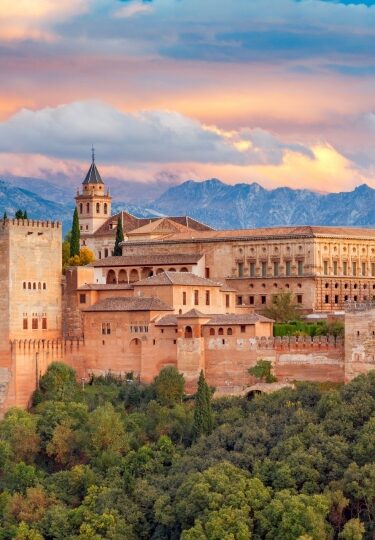From a shimmering Mediterranean coast to buzzing cities and serene countryside, Spain is home to some of the world’s most beautiful places. The country’s breathtaking natural landscape offers vast volcanic vistas, pine-covered islands, and blissful beaches.
You’ll also find remarkable manmade landmarks, from eye-popping modern architecture and sprawling Gothic churches to ancient towns and medieval castles.
Explore Spain’s incredible diversity on the mainland and among the islands, from the volcanic Canary Islands scattered across the Atlantic to the sun-drenched Mediterranean vacation spots of the Balearics.
Here are some of the most beautiful places in Spain to visit.
Maspalomas Beach, Gran Canaria
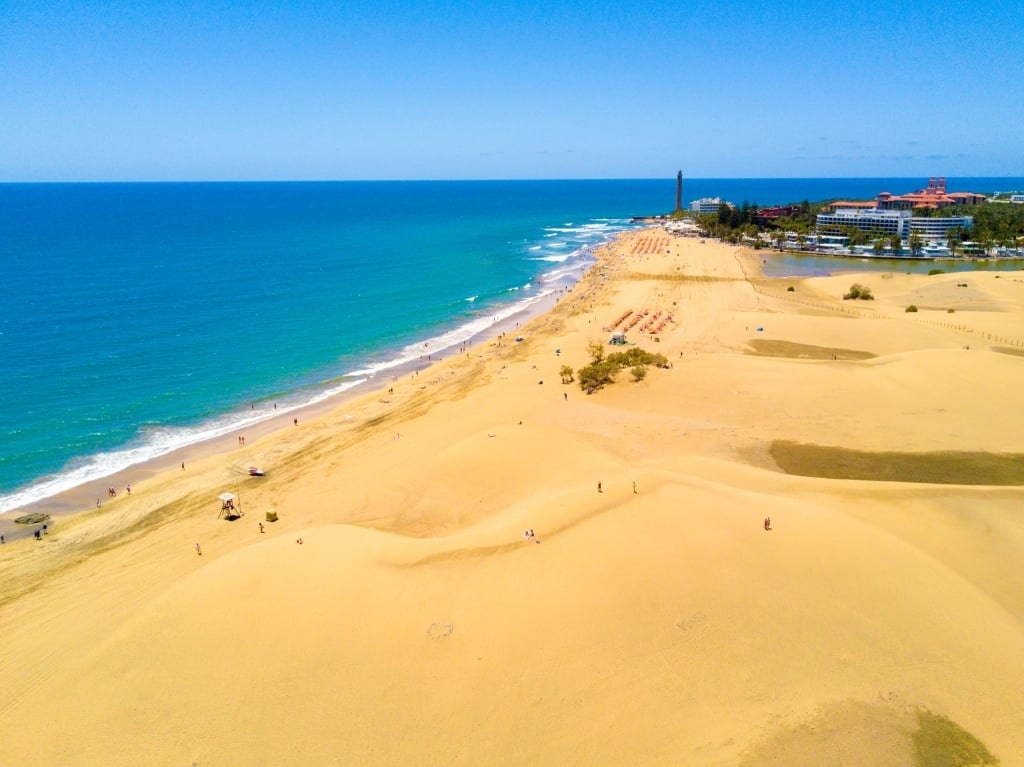
Maspalomas Beach, Gran Canaria
A golden Sahara-like landscape on the south coast of Gran Canaria in the Canary Islands, Maspalomas Beach is one of the prettiest places in Spain. What makes this designated nature reserve stand out? The roughly 1,000-acres of undulating dunes that peak and dip, a shimmering brackish lagoon, and shady palm grove.
To preserve the dunes, authorities have set out strict guidelines on where visitors can wander. Stroll the five-mile track to admore the ripples of sand contrasting with the deep-sapphire blue of the Atlantic Ocean in the background. Visiting here is one of the best things to do in Gran Canaria, as its endless sands offer excellent swimming and surfing, too, year round.
Sagrada Família, Barcelona
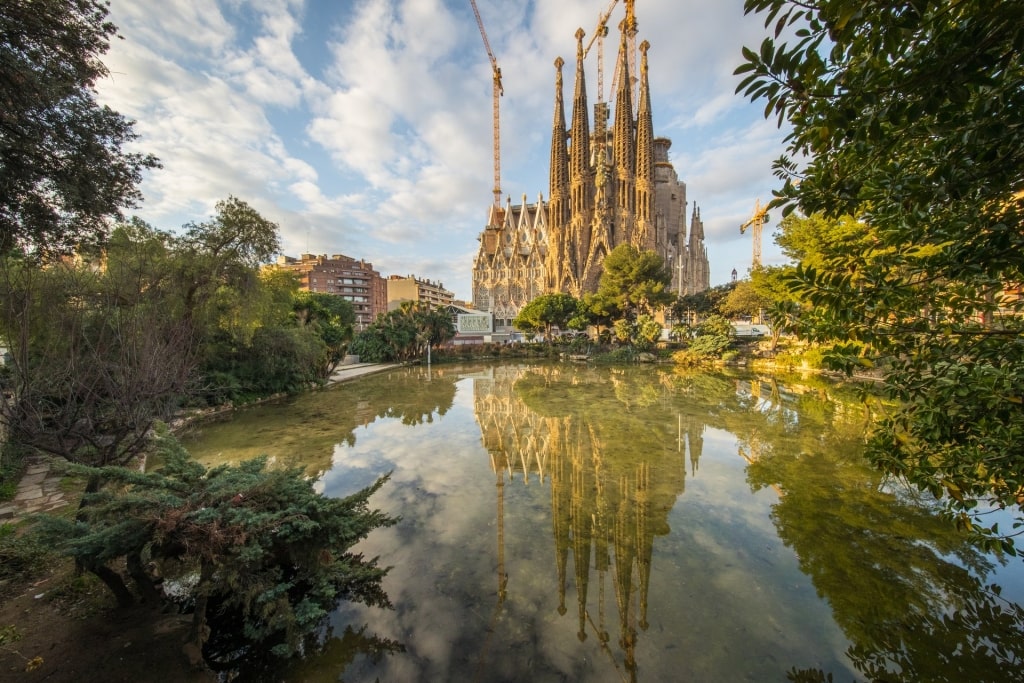
Sagrada Família, Barcelona
Barcelona is filled with beautiful landmarks, though the unfinished Sagrada Familia is arguably the city’s star attraction.
Designed by revered Catalan architect Antoni Gaudí, the build of this towering Spanish church began in 1882 and gained UNESCO World Heritage status in 1984, along with some of the city’s other Gaudi-designed buildings, including Park Guell and Casa Mila.
Upon completion, which is projected for 2026, the church’s will feature a total of 18 impossibly tall, skinny spires, representing the 12 apostles, the Four Evangelists, the Virgin Mary, and Jesus Christ. Organic shapes, wavy forms and bright colors adorn the facades and the interior.
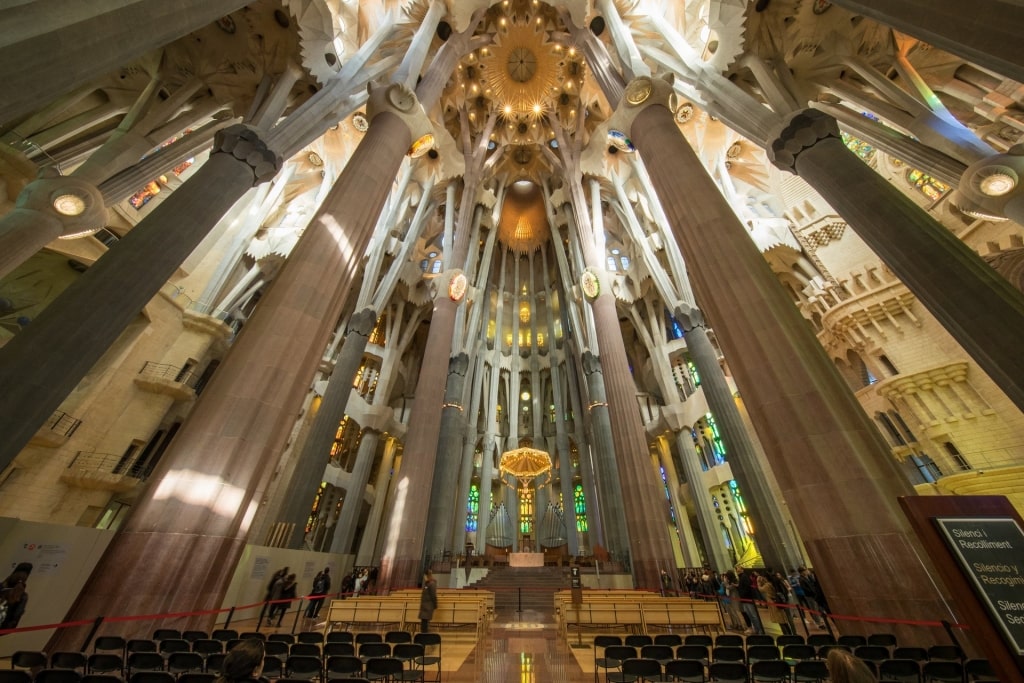
Sagrada Família, Barcelona
There’s plenty to admire from the outside of this iconic Spanish landmark, but it’s well worth stepping inside, too; you’ll have the illusion of being in a man-made forest of tall, slender trees, light filtering through the stained glass windows in pools of brilliant color.
Gaudí’s tomb lies in the El Carmen Virgin chapel, located in the Sagrada Familia’s lower ground level, where you can pay tribute to this iconic architect.
Royal Alcázar, Seville
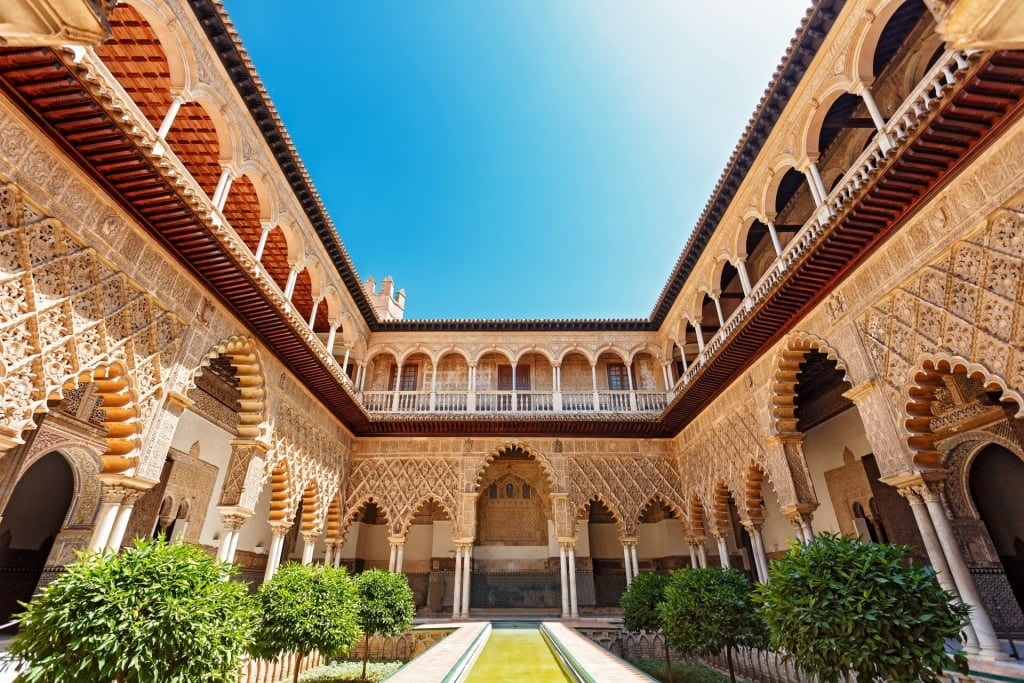
Royal Alcázar, Seville
The extraordinary Royal Alcazar in Seville is a complex of walled palaces and courtyards—including the Stucco Palace, with its Hall of Justice, the Mudéjar Palace, and the Gothic Palace—lying in the center of this vibrant, sun-drenched city in the heart of Andalucia.
Developed over hundreds of years by the Moors, who ruled Andalucia from the eighth century, the Royal Alcázar of Seville is regarded as one of the most beautiful places in Spain, earning UNESCO World Heritage status in 1987, along with Seville Cathedral and the Archive of the Indies. The Spanish royal family still uses parts of the palace to this day.
Wander through the delightful gardens adorned with sculptures and tranquil fountain-filled ponds that make this one of the most romantic places in Spain. The courtyards are just as impressive, with beautiful mosaic tiles and intricate arches. Look out for the palace’s magnificent Renaissance tiled altar, made by Francisco Niculoso Pisano in 1504.
Cathedral of Murcia, Cartagena
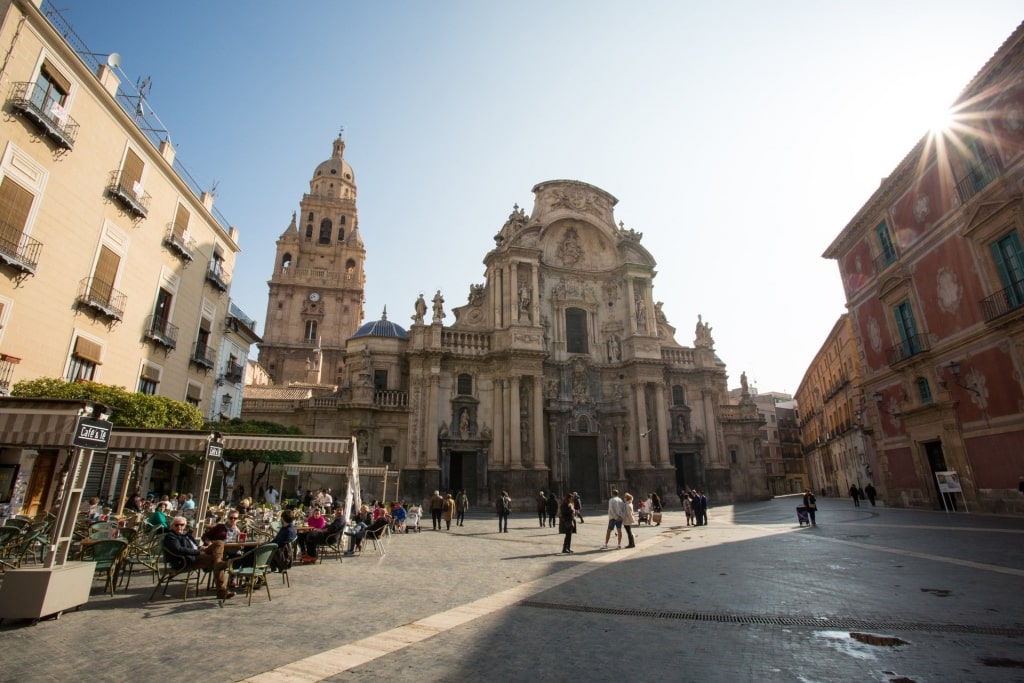
Cathedral of Murcia, Cartagena
Built on the site of a former mosque, the elaborate Cathedral of Murcia took 73 years to build and was completed in 1465. With a Gothic and Renaissance interior, and an elaborate Baroque facade, like many of Spain’s gargantuan historic buildings, the Cathedral of Murcia has been added to over the centuries and features characteristics from several different periods.
The honey-colored Cathedral is the darling of the city of Cartagena. Visit the museum, set inside the old cloister that predates the cathedral, to view archeological remains and religious objects that have been uncovered during various stages of renovation works.
Atalaya Castle, Alicante
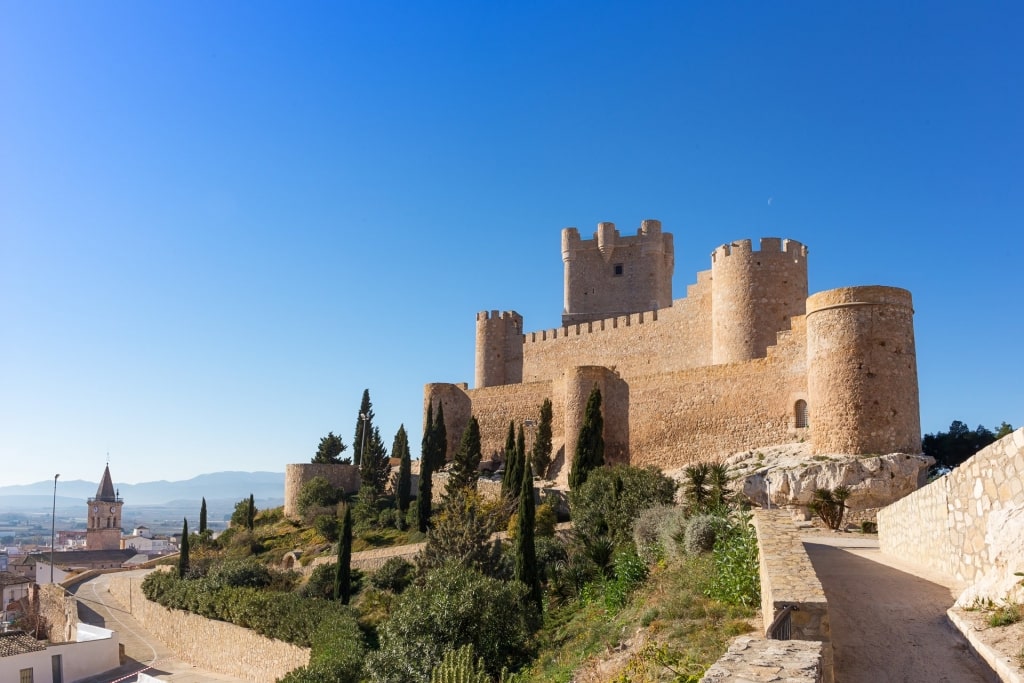
Atalaya Castle, Alicante
The imposing sandstone Atalaya Castle gazes out over the town of Villena, a 40-minute drive from Alicante. With emerald-green cypresses dotted around the three-story, double-walled fortress, guarded by a central turreted tower, the solid Atalaya Castle is a sight to behold.
Constructed during the Almohad Empire, Atalaya Castle was originally built as a refuge for the Muslim population of the town at the end of the 12th century. It has since been resided in by princes and powerful dynasties. Look out for the graffiti on the walls of the fortress’s cells, a reminder of the castle’s role in the Germanías War, the War of the Spanish Succession, and the Peninsular War.
Once you’ve admired the Spanish castle, it’s worth roaming the narrow winding streets of Villena. The city’s characterful traditional houses are painted in a rainbow of colors.
Old Quarter, Bilbao
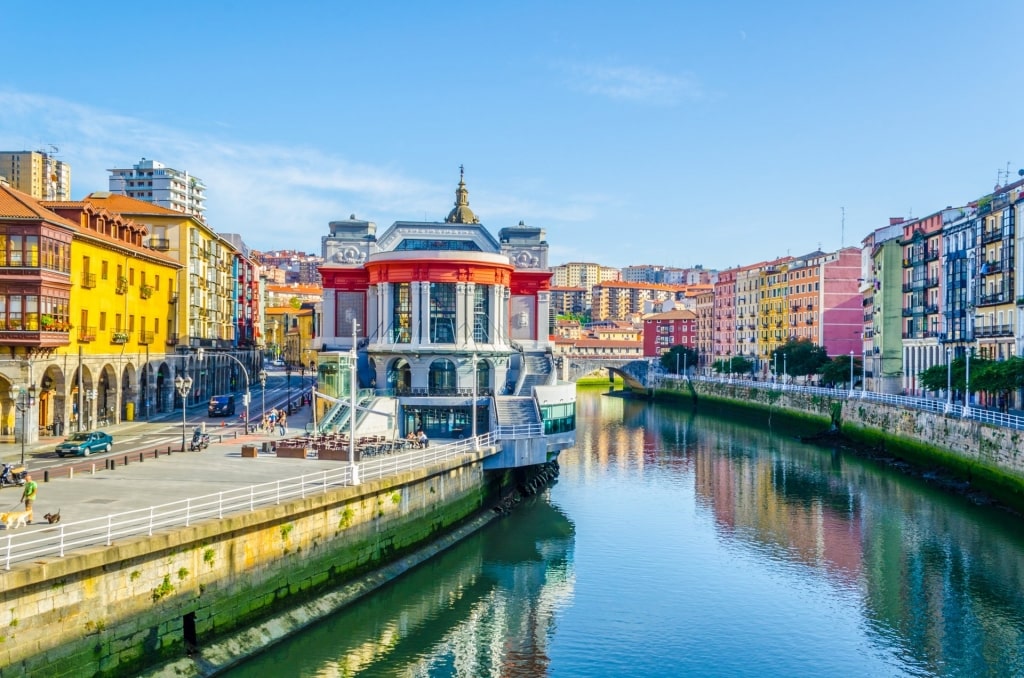
Old Quarter, Bilbao
The Old Quarter of Bilbao, with its winding cobbled streets and beautiful balconied buildings, is one of the prettiest places in Spain. The historic center of this Basque Country city, snuggled between the grand Plaza Nueva Square and the Estuary of Bilbao is famous for the “Seven Streets”.
This medieval heart of the city lies south of Bilbao’s neo-Gothic cathedral and is buzzing with boutiques and galleries. Filled with quaint cafes, tasty pintxos bars, and quirky stores, the Old Quarter has a wonderful ambiance especially during fall in Spain, whether you’re here to snack or shop.
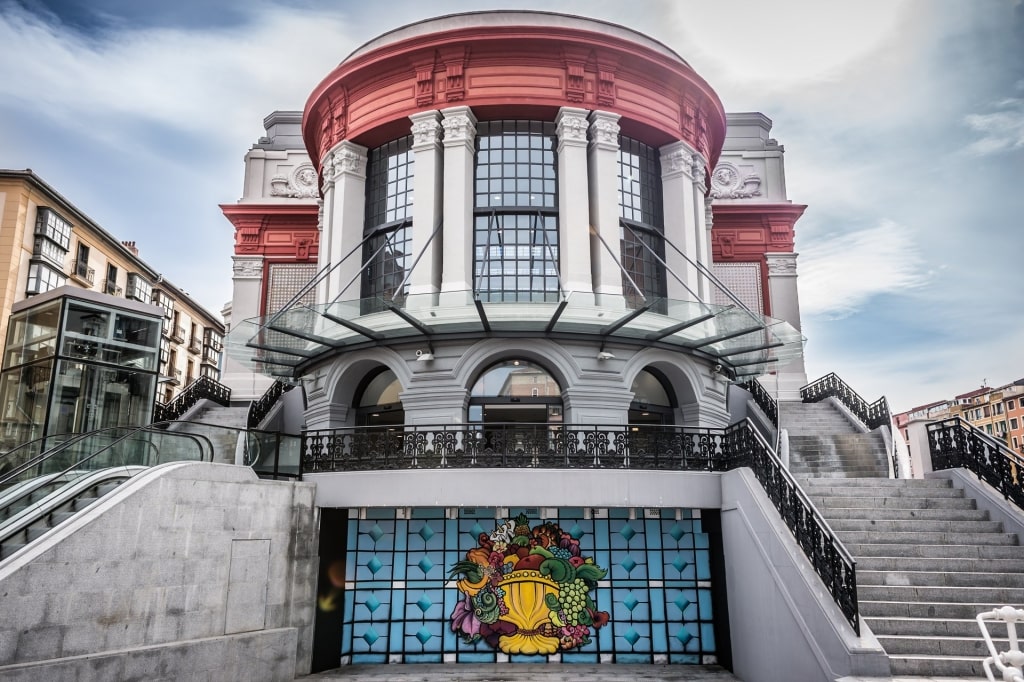
Mercado de la Ribera, Bilbao
Europe’s largest indoor market, Mercado de la Ribera can also be found in Bilbao’s Old Quarter. Art Deco touches adorn this sprawling, 1929-built market hall.
You’ll find all sorts of land and sea produce sold inside here, including Biscayan orchard fruits and vegetables, fresh-off-the-boat fish, artisan bread, cheese, cured meat, mushrooms, pickles, and preserves.
Mijas, Malaga
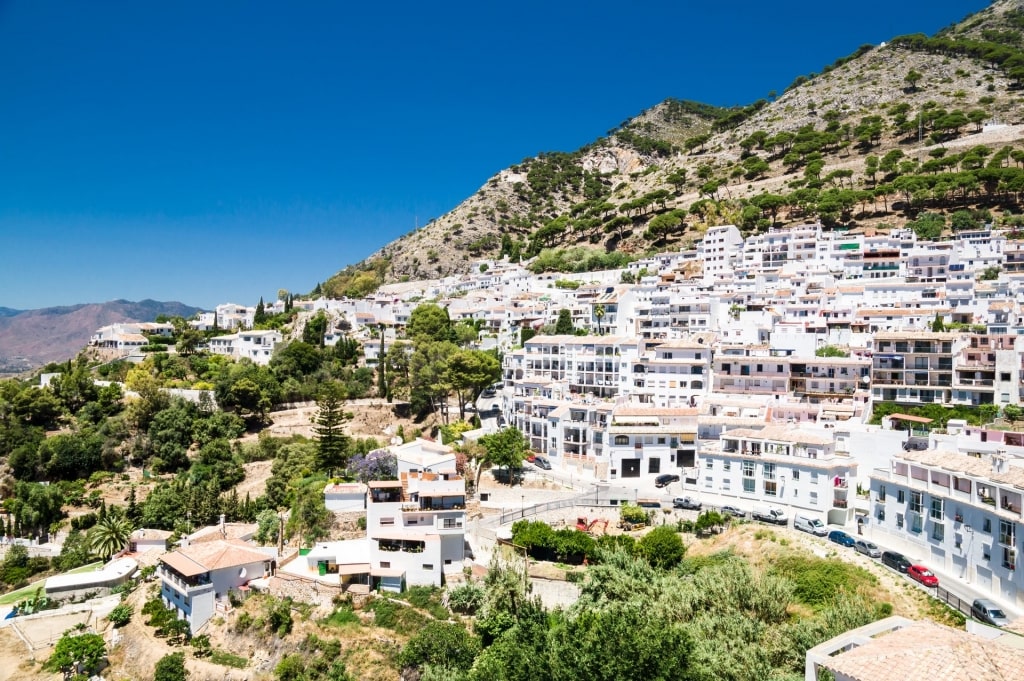
Mijas, Malaga
The hilltop town of Mijas, one of Andalucia’s “pueblos blancos”, or white towns, is among the prettiest places in Spain thanks to its traditional whitewashed buildings, vibrant bougainvillea and pops of blue from bright ceramic pots that adorn every house.
The town sits 1,280 feet above sea level, overlooking the resort of Fuengirola, just a 30-minute drive from Malaga. Because it’s set back from the coast in the hills, Mijas enjoys a sense of being off-the-beaten-track. The town is filled with restaurants, cafes, and bars, and the galleries and boutiques stock locally made ceramics, art, linens, and items such as olive oil and lavender-scented perfume.
Stroll the terraced, cobbled streets to reach one of the lookout points for hypnotic views of Mijas’ terracotta rooftops, the forested Sierra de Mijas mountain range, and the azure water of the Mediterranean in the distance. Once you’ve shopped and explored, take a break in a sun-dappled courtyard and refuel with a selection of local tapas.
Seville Cathedral, Seville
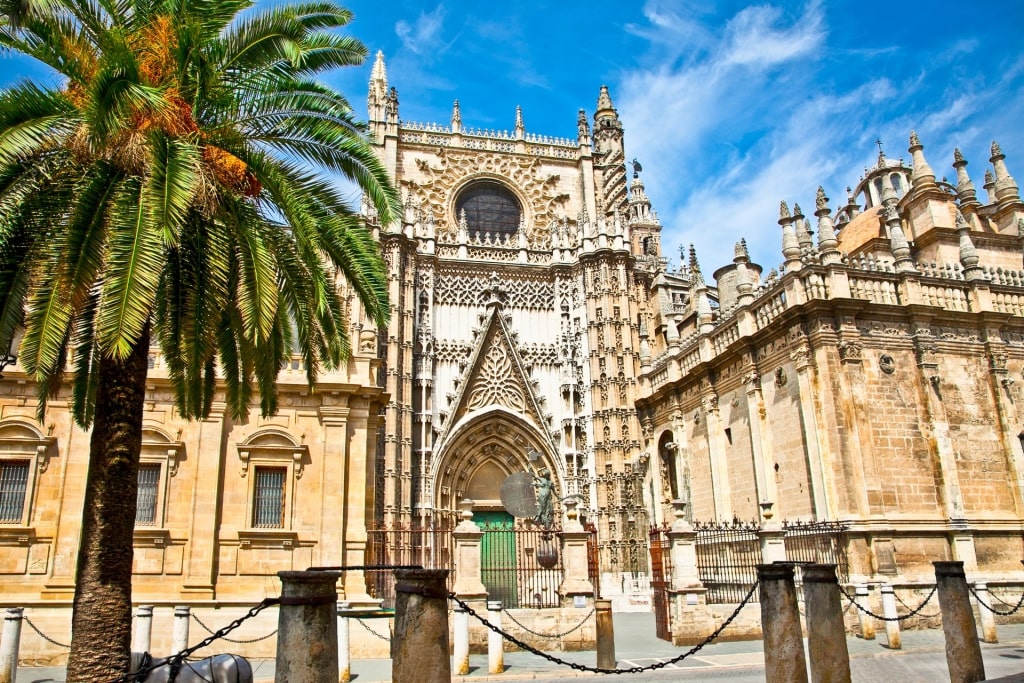
Seville Cathedral, Seville
Dominating the city’s skyline, Seville Cathedral is one of the most beautiful places in Spain. Construction of the cathedral began in 1401, lasting until the following century when it was finally completed in 1506. Over 500 years later, Seville Cathedral remains the largest Gothic cathedral and one of the largest churches in the world.
Admire some of the 80 side chapels split between two rows and the 137-foot-tall central nave. Step inside the nave to gaze at the central altarpiece—a breathtaking work of art featuring more than 200 figures of saints.
If you can tear your eyes away, visit the cathedral’s elaborate bell tower, the Giralda, which predates the main church as the former minaret of the Great Mosque of Seville, which once stood on this site. Inside the tower, ramps spiral up to the top, originally designed to accommodate horses, not pedestrians.
Guggenheim Museum, Bilbao
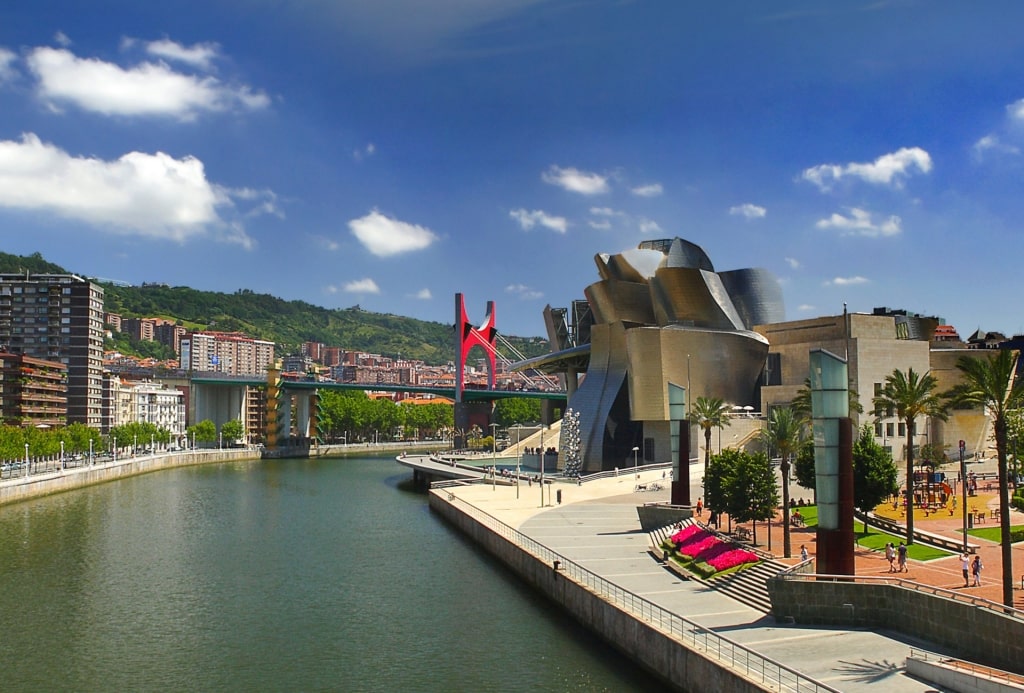
Guggenheim Museum, Bilbao
It was only fitting that the landmark Guggenheim Museum Bilbao, housing works by some of the world’s most prominent contemporary artists, would take on a groundbreaking, modern form itself.
Opened in 1997 next to Bilbao’s Puente La Salve Bridge, by the Nervion River, the museum was designed by Pritzker Prize-winning architect Frank Gehry. The Guggenheim Museum Bilbao’s modern aesthetic features a mound of galvanized titanium and glass, all curves, cliffs and jutting prows, the shimmering tiles resembling the scales of a fish.
As one of the best museums in Spain, the art is pretty extraordinary, too. Check out the spindly, 30-foot-tall spider installation, “Maman”, by artist Louise Bourgeois. The bronze, marble, and stainless steel sculpture greets visitors at the entrance to the museum. Inside, there’s a large, light-filled atrium with views of the river and changing themed exhibitions, from Russian to Chinese to Basque Country art.
Alhambra Palace, Granada
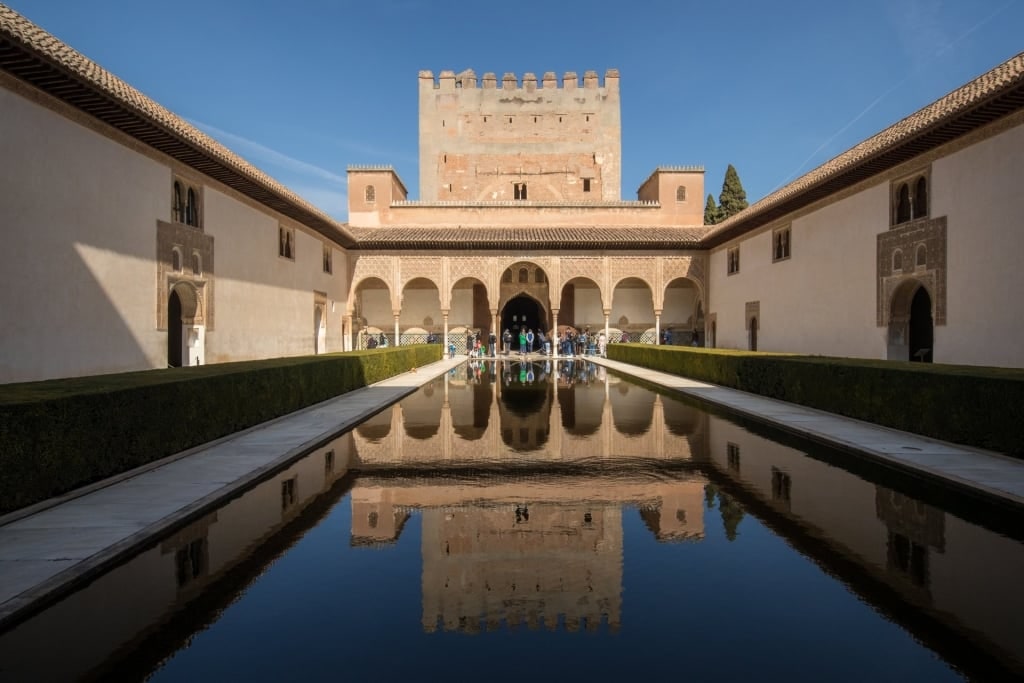
Alhambra Palace, Granada
The 13th-century Alhambra Palace is a sublime example of Moorish architecture in Spain. Located west of Granada, the fortress palace, built from warm, red sandstone, sits on a hilltop, elevated above the surrounding towns and surrounded by a fragrant, green forest of horse chestnuts, hackberries, laurels, and poplars. A backdrop of the snowy Sierra Nevada mountains completes the picture of one of the most beautiful places in Spain.
Every inch of the palace is exquisitely tiled and carved; the attention to detail is incredible and almost overwhelming. Wander around the cool, leafy courtyards and explore the Alhambra Museum, located on the south wing of the Palace’s lower level.
Dedicated to Moorish culture and art, the museum is split into several exhibition rooms covering a range of themes. Afterward, take in the serene beauty of the Generalife gardens, with a soundtrack of whispering mountain breezes and splashing fountains.
La Laguna, Tenerife
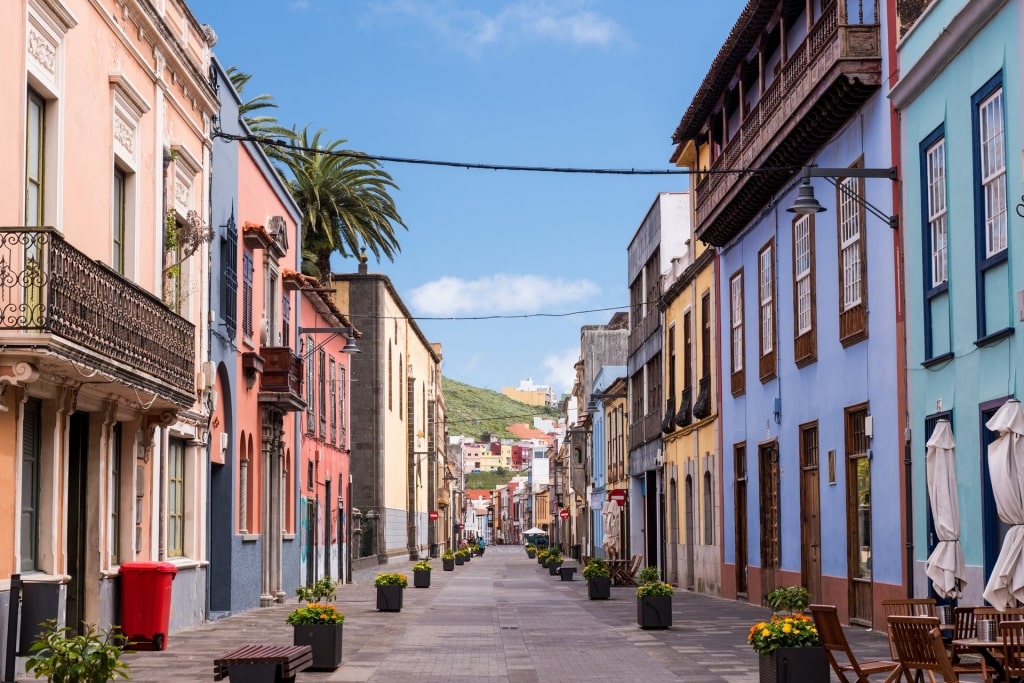
La Laguna, Tenerife
A must-do in Tenerife is to visit San Cristóbal de la Laguna, one of the prettiest places in Spain. Just six miles from the island’s capital, Santa Cruz de Tenerife, San Cristóbal de la Laguna is a designated World Heritage Site. If you roam the city’s attractive streets, you’ll soon understand why.
The charming city—one of the earliest cities to be established in the Canary Islands—features pastel-colored traditional houses with stone porticoes and gorgeous leafy courtyards. La Laguna’s 16th-century town plan even formed a blueprint for subsequent Spanish colonial towns in the Americas, including Old Havana in Cuba.
Discover the city’s Santa Catalina and Santa Clara monasteries, the ornate Leal Theater, and the Museum of the History of Tenerife. You’ll find plenty of tapas bars here for snacks after your visit, from spicy patatas bravas to creamy croquettes.
Read: Best Beaches in Tenerife
La Seu Cathedral, Palma de Mallorca
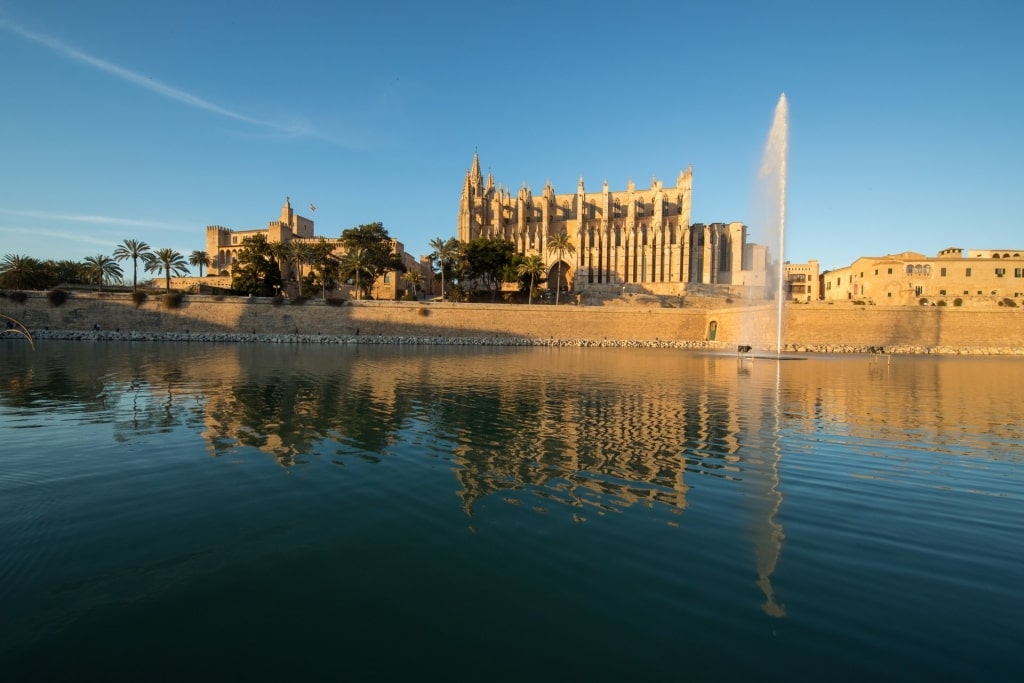
La Seu Cathedral, Palma de Mallorca
Le Seu, Palma’s grand cathedral, is impossible to miss. Flanked by lofty palm trees, this hulking Gothic masterpiece dominates the sweep of the Bay of Palma. The cathedral was completed in 1601 and has been added to during various renovations over the centuries.
Take a walk around the outside of the cathedral to fully appreciate its dazzling beauty. Check out the dizzying, 114-foot nave, the elaborate altar, and gigantic stained-glass windows. The main door and south door are particularly impressive, featuring sculptures by Gothic artist and architect Guillermo Sagrera.
Aficionados may recognize the hand of Catalan architect Antoni Gaudí, who was commissioned to work on the restoration of the cathedral in the early 20th century. While Gaudí never put his proposals into practice after falling out with the Bishop at the time, the stark Crown of Thorns chandelier that hangs over the altar is the work of one of his disciples.
City of Arts and Sciences, Valencia
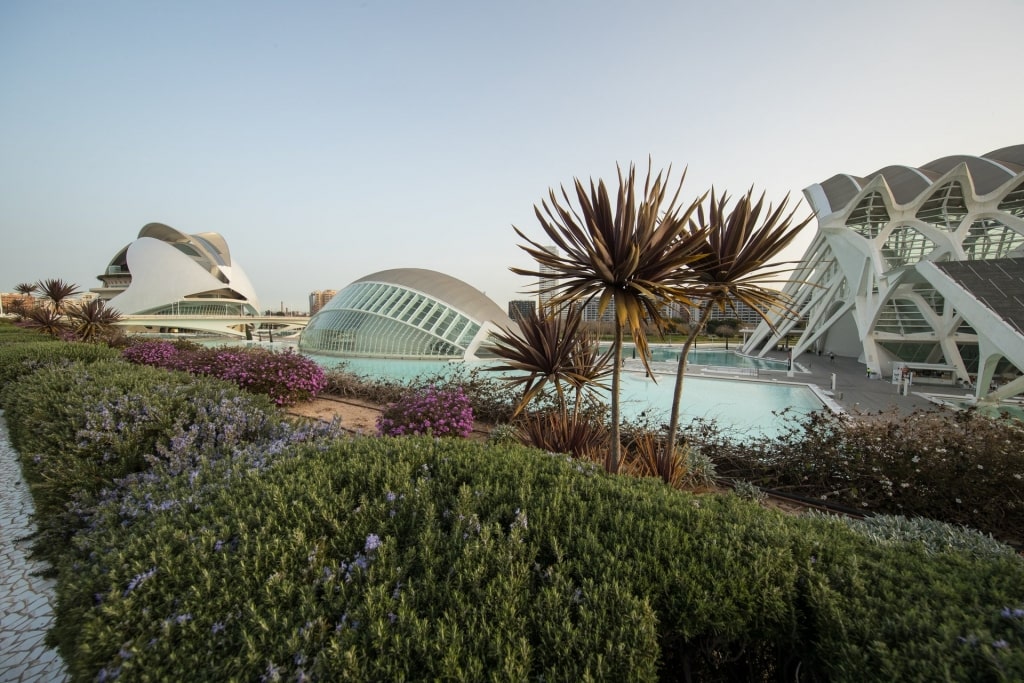
City of Arts and Sciences, Valencia
The City of Arts and Sciences is built on the former riverbed of the River Turia that snaked through the city before it was diverted away from the center. This futuristic complex of curvy, light-filled buildings, reflected in shimmering pools, showcases the work of Valencian architect Santiago Calatrava (who also designed The Oculus in New York) and Félix Candela.
Surrounded by neatly manicured gardens, the City of Arts and Sciences offers plenty to see, including the Hemisfèric, an IMAX cinema; the Umbracle vantage point; the Príncipe Felipe Science Museum; the Oceanogràfic aquarium; the Reina Sofía Palace of the Arts, which is dedicated to opera, and the Ágora concert space.
If you only have limited time, focus on one or two of the attractions. The Oceanogràfic, Europe’s largest aquarium housing 500 marine species, and the Príncipe Felipe Science Museum are a good start. Stroll over the stunning Calatrava and Candela-designed Assut d’Or Bridge, which crosses the former riverbed between the Science Museum and the Ágora. Stop for a picnic or an ice cream and take in the view of these extraordinary buildings.
Timanfaya, Lanzarote
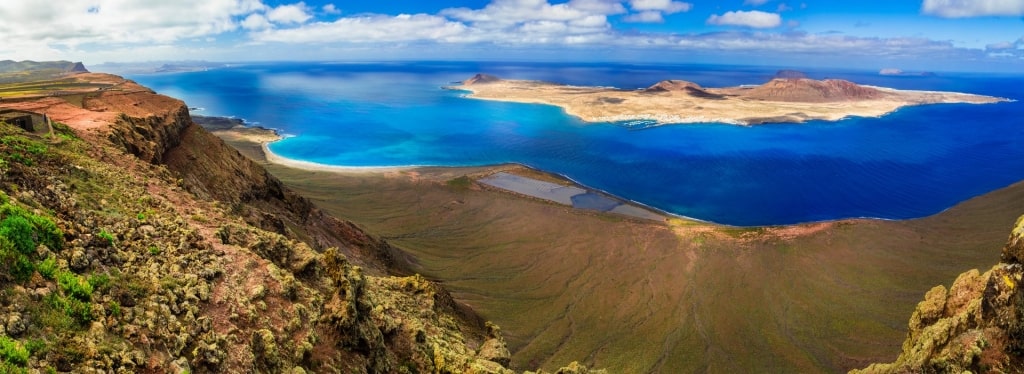
Timanfaya, Lanzarote
A world away from the black-sand beaches and whitewashed resorts of Lanzarote, in the center of the island, you’ll find the stark Timanfaya National Park, a UNESCO Biosphere Reserve and one of the most beautiful places in Spain.
The lunar-like, undulating landscape of Timanfaya is the work of centuries of volcanic eruptions, the last one occurring roughly 300 years ago. Rippling, ochre-tinged sand dunes and black volcanic plains are dominated by the spine of the Montañas del Fuego, or Fire Mountains.
Read: Most Beautiful Mountains in the World
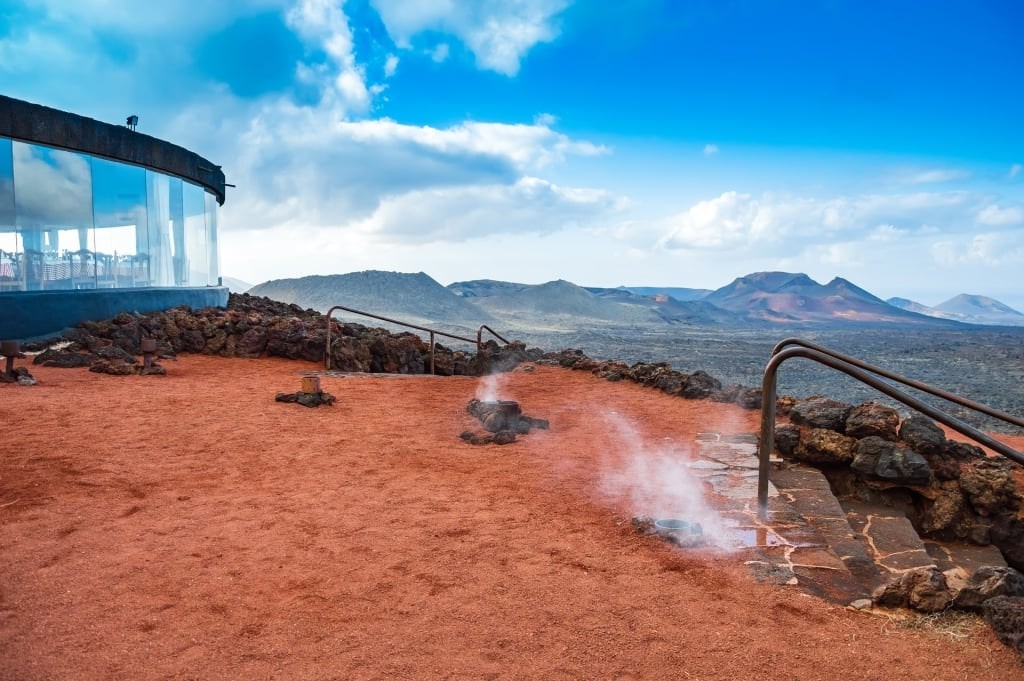
Timanfaya, Lanzarote
Timanfaya offers some of the best things to do in Lanzarote, from hiking to riding a camel, an otherworldly experience against the backdrop of the multi-colored dunes. Watch the park rangers perform their tricks; water poured into a hole in the ground erupts seconds later with a whoosh, as a steaming geyser.
At the park’s Diablo Restaurant, the food is cooked theatrically, steaks sizzling over a grill powered by geothermal heat from the ground. Try a Canarian favorite, boiled potatoes with the islands’ popular spicy mojo sauce, washed down with a glass of white wine, produced nearby in La Geria.
Castle of Santa Bárbara, Alicante

Castle of Santa Bárbara, Alicante
One of the largest medieval fortresses in Europe, Alicante’s Castle of Santa Bárbara dominates the city. Built in the ninth century, during Spain’s Muslim era, it was eventually captured by Christian forces in the 13th century
This history gives it a mix of Moorish, Gothic, and Renaissance styles. The present name comes from its conquest on the feast day of Saint Barbara, December 4.
The castle’s strategic setting high on Monte Benacantil makes the breathtaking 360-degree views from its walls enough reason to visit. However, the tall central keep and impressive defensive bulwarks will fascinate anyone with an interest in military history.
Casa Batlló, Barcelona

Casa Batlló, Barcelona
When industrialist Josep Batlló wanted a family home in 1904, he turned to Antoni Gaudí. Gaudí had a free hand, creating the fantasy we see on Passeig de Gracia today, with its remarkable facade and imaginative interior. It also has some of the best views in Barcelona.
Beautiful in itself, Casa Batlló is only one of a row of houses designed by some of Gaudí’s contemporaries. Casa Amatller, Casa Lleó Morera, Casa Mulleras, and Casa Josefina Bonet are all remarkable examples of their Modernist style.
As another bonus, the Casa Batlló Store has been named among the best museum shops in the world. You’ll find a carefully curated choice of gifts related to Gaudí and to Barcelona.
Casa Mila, Barcelona
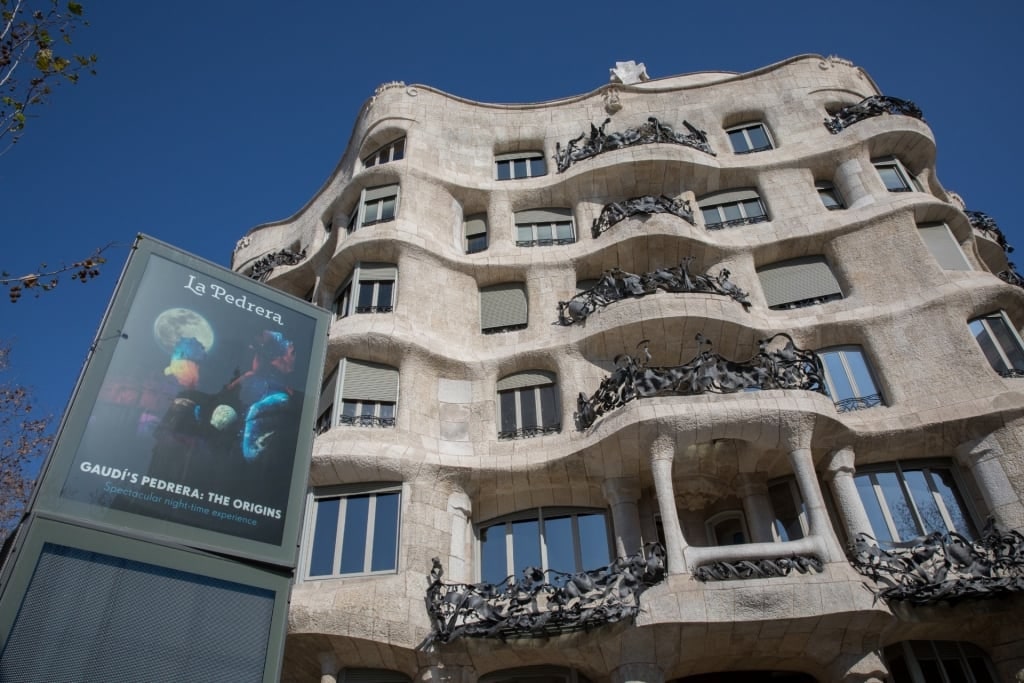
Casa Mila, Barcelona
Another house by Antoní Gaudí, Casa Milà is nicknamed “La Pedrera” (“The Quarry”) due to its unusual stone facade. Now recognized by Unesco as a modernist icon, the witty, surrealistic details make it a delight for any visitor.
Casa Milà was built in 1912 for industrialist Pere Milà and his wife Roser Segimon. They commissioned it as a series of offices, workspaces, and apartments.
Revolutionary details at the time included an underground parking lot and a central courtyard that gave the interior both ventilation and natural light.
Bermeo, near Bilbao
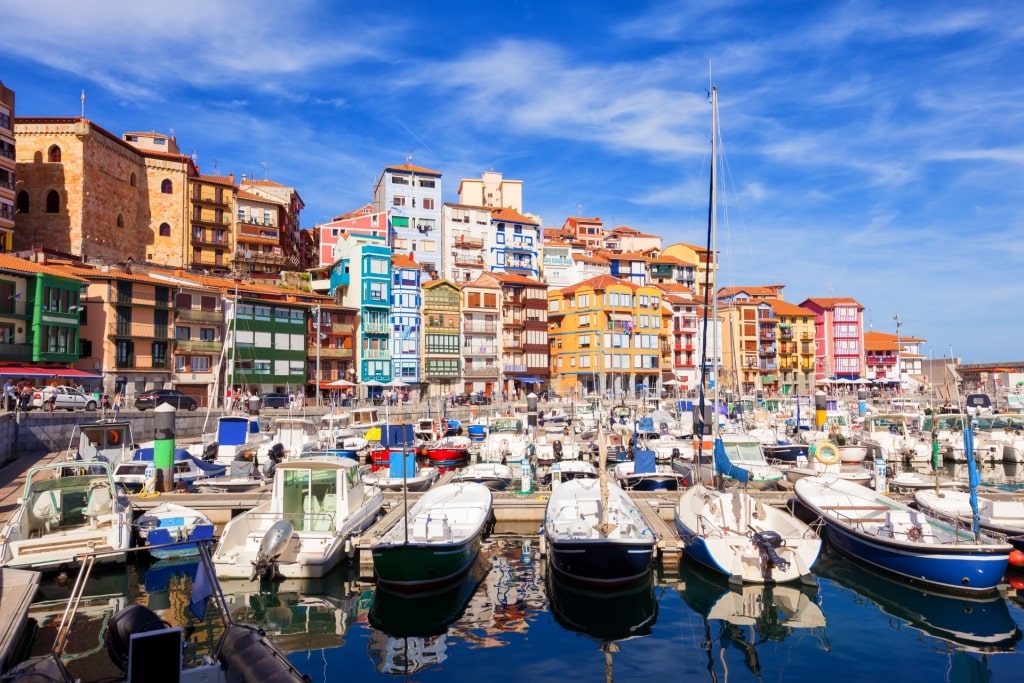
Bermeo, near Bilbao
This colorful coastal village was the center of the former Basque whaling trade. The wealth from that can be seen invested in its civic buildings and beautiful old port.
The old town around the still-busy harbor is lined with colorful houses. Anywhere sailors use to congregate is well served with bars and Bermeo is no exception.
On the way to or from Bilbao, you’ll pass the impressive fortress island of San Juan de Gaztelugatxe (“Castle Rock” in the Basque language.) You might recognize it from appearances in a long-running TV series.
La Concha Beach, San Sebastian, near Bilbao
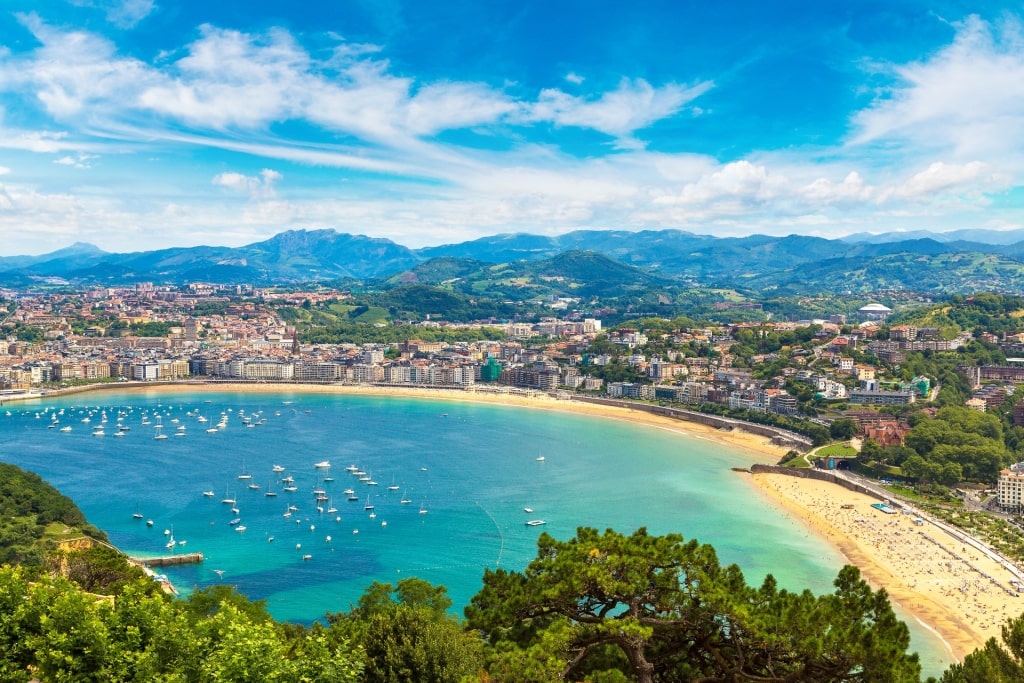
La Concha Beach in San Sebastian, near Bilbao
One of Spain’s best beaches, La Concha is named for its deeply curved, shell-like shape. This sheltered bay makes it the perfect haven for swimmers, kayakers, or sunbathers.
Besides its own picturesque setting, La Concha also looks out on the beautiful island of Santa Clara. Enjoy these views with a stroll on Paseo de la Concha behind the beach or by taking the funicular to the lookout on Monte Igueldo.
Monte Igueldo also holds an old-fashioned amusement park, a delight for photographers. On the other side of the beach, Monte Urgull has an historic castle and hiking trails to even more panoramic views.
Rioja Wine Region, near Bilbao
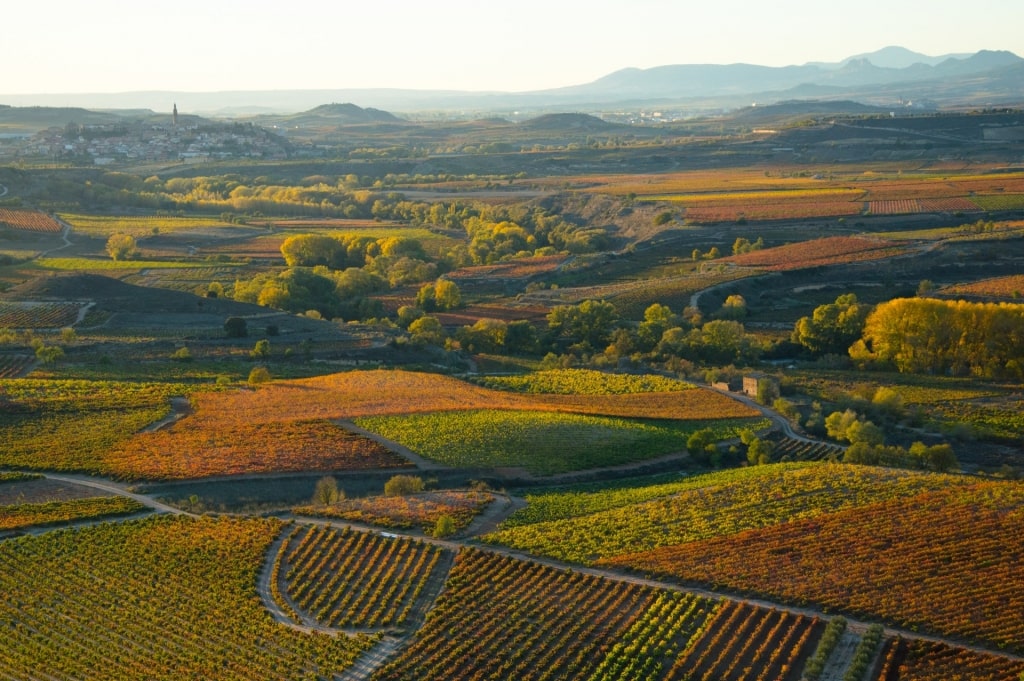
Rioja Wine Region, near Bilbao
On top of being home to its best-known wine, the Rioja region is one of the most beautiful places in Spain. It sits in the Ebro River Valley, covering parts of three provinces, with a variety of terroirs.
There are around 500 wineries, large and small, to discover in this lovely region. Wine tours and tastings are an essential way to learn more about its history and culture.
In the village of Briones, only an hour from Bilbao, you can find the Vivanco Museum of Wine Culture. The capital of the region is Logroño, another delightful place to find a bar or restaurant to sample Rioja.
Castillo de Santa Catalina, Cadiz
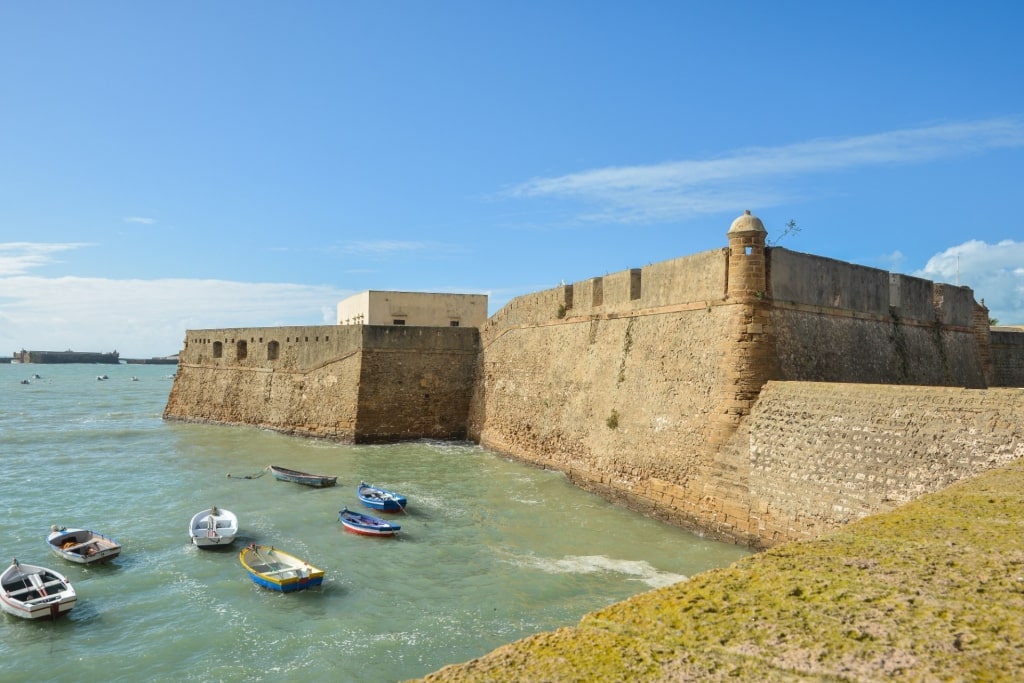
Castillo de Santa Catalina, Cadiz
Santa Catalina Castle was built in 1602 to defend Cadiz from Ottoman privateers and other enemy forces. At the time, these included the English, French, and Dutch.
Its elegant Renaissance style is also highly functional, with thick stone walls and bastions enjoying strategic views of the coastline. The fortress played a significant role in the defense of Cádiz during the Napoleonic Wars.
As well as discovering its military history, visitors can still enjoy those panoramic views. The castle holds regular cultural events including exhibitions and concerts.
Roman Theater Cartagena, Cartagena
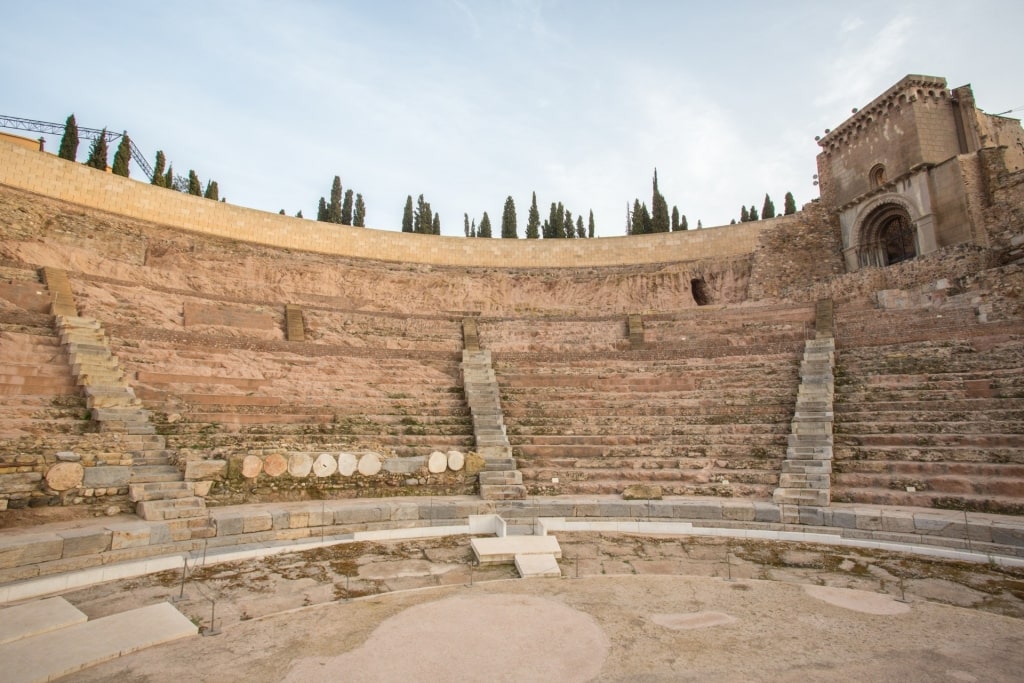
Roman Theater Cartagena, Cartagena
Cartagena’s Roman Theater was one of the largest on the Iberian Peninsula when it was built just over 2,000 years ago. It could hold 7,000 spectators, using the natural slope of Concepcion Hill as its arena base.
The ancient remains were only discovered in 1988 during construction of the new Regional Craft Center. Excavation and restoration work was completed by 2003, with the striking onsite museum opening in 2008.
Architect Rafael Money, known for works such as LA’s Cathedral of Our Lady of the Angels, has done a remarkable job on the museum building. Inside, you can follow an ingenious journey through time before you emerge into the ancient theater itself.
D’Alt Vila, Ibiza
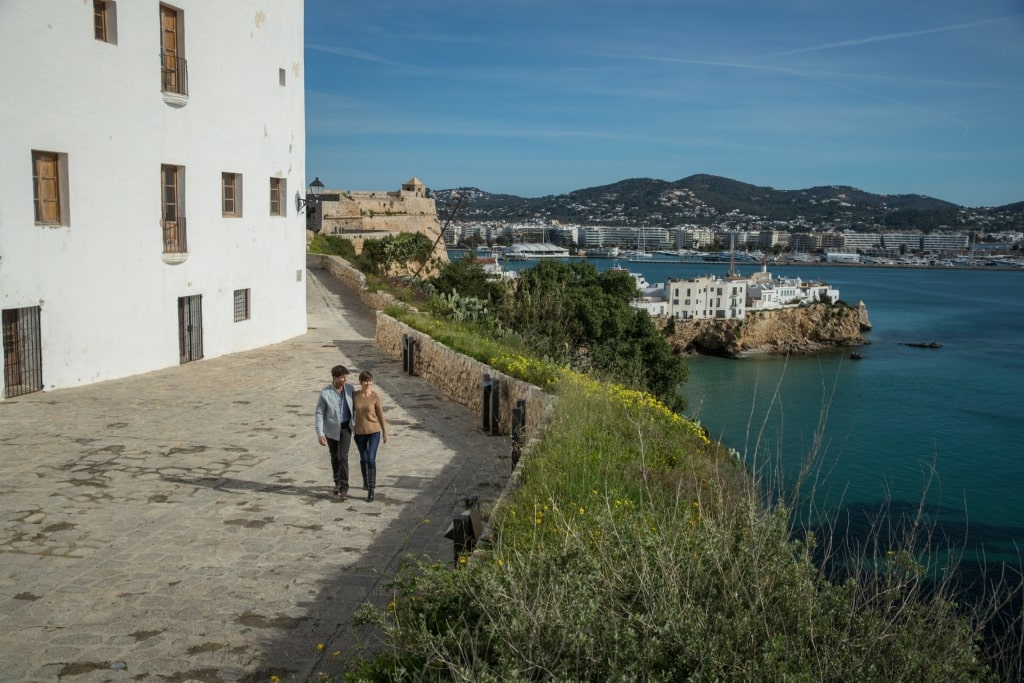
D’Alt Vila, Ibiza
You enter Ibiza’s old quarter, the fortified Dalt Vila or “High Town”, through a drawbridge. Inside the town’s high walls are cobbled streets that lead you through a warren of narrow passages, many accessible only on foot.
Around every corner, you can expect a small adventure, even if it’s only browsing a delightful craft shop. Restaurants, museums, and art galleries will tempt you to linger for days.
This beautiful old town of Ibiza sits on a high hill near the sea and the views from its battlements across the sparkling Mediterranean to the neighboring island of Formentera are panoramic. Pick up a map from the tourist office to follow the information plaques or have a local guide show you the highlights.
Tower of Hercules, La Coruña

Tower of Hercules, La Coruña
The oldest lighthouse in the world still in use has stood outside the harbor of La Coruña since the 1st century A.D. Built during the reign of Emperor Trajan in typical Roman style, it is beautiful in its functional simplicity.
The tower takes its name from a legend that it was built by Hercules, the mythical Greek hero. Its design is said to follow that of the Lighthouse of Alexandria, one of the Seven Wonders of the Ancient World.
It stands 180 feet high on a rock that is equally high. There is an interesting information center but most visitors come to enjoy the amazing Atlantic Ocean views.
Vegueta, Gran Canaria, Canary Islands
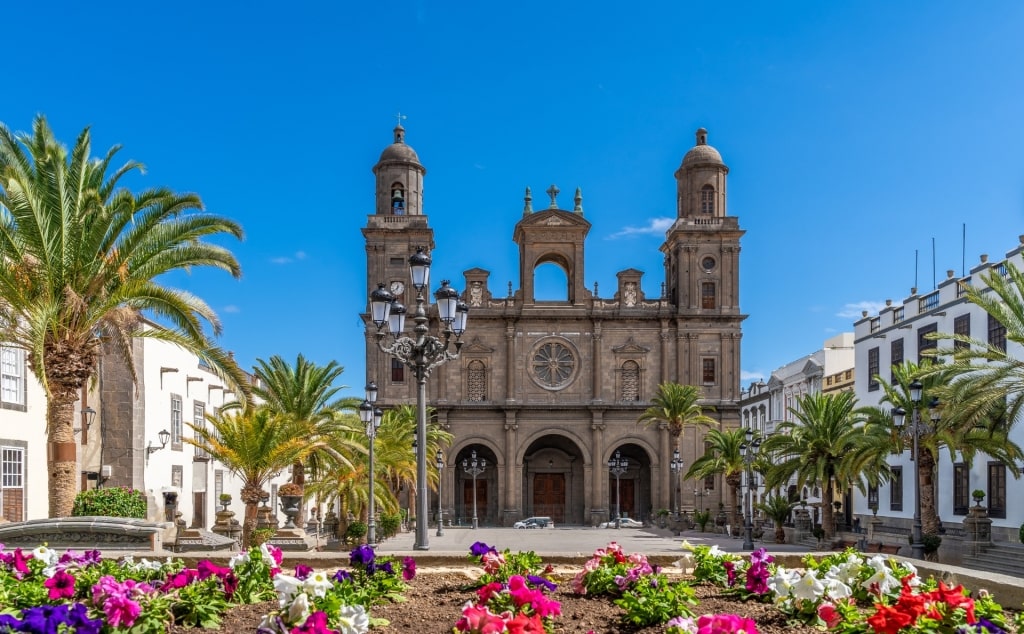
Vegueta in Gran Canaria, Canary Islands
Vegueta is a historic neighborhood of Las Palmas, the capital of Gran Canaria. It’s the pretty heart of the original city, which was founded in 1478.
This long history has given Vegueta a wealth of traditional Canarian-style houses and many other notable buildings. These include the Cathedral of Santa Ana, Casa de Colón (Columbus House), and the Plaza de Santa Ana.
Christopher Columbus is thought to have stayed in Casa de Colón during his voyage to the Americas in 1492. It’s now a museum of exploration and maritime history.
Teide National Park, Tenerife, Canary Islands
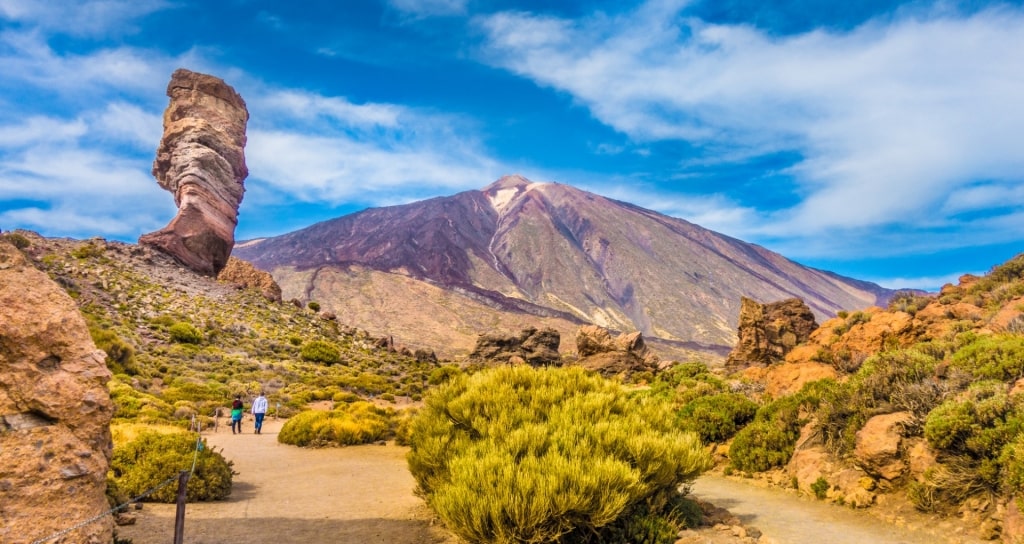
Teide National Park in Tenerife, Canary Islands
The highest peak in Spain, Mount Teide is the heart of a National Park that is a Unesco World Heritage Site. The park’s unique volcanic landscape of craters and sinuous lava flows make it one of the most beautiful, if otherworldly places in Spain.
Teide is the world’s third-largest volcano from peak to base and stands 12,198 feet above sea level. You can explore the slopes covered in forests and unusual rock formations on various hiking trails.
From the summit, you can see the neighboring islands of La Gomera, La Palma, and El Hierro rising above the heat haze. An observatory uses the high altitude and clear skies here for astronomical research.
Read: Things to Do in Tenerife
Alcazaba Palace & Gibralfaro, Malaga
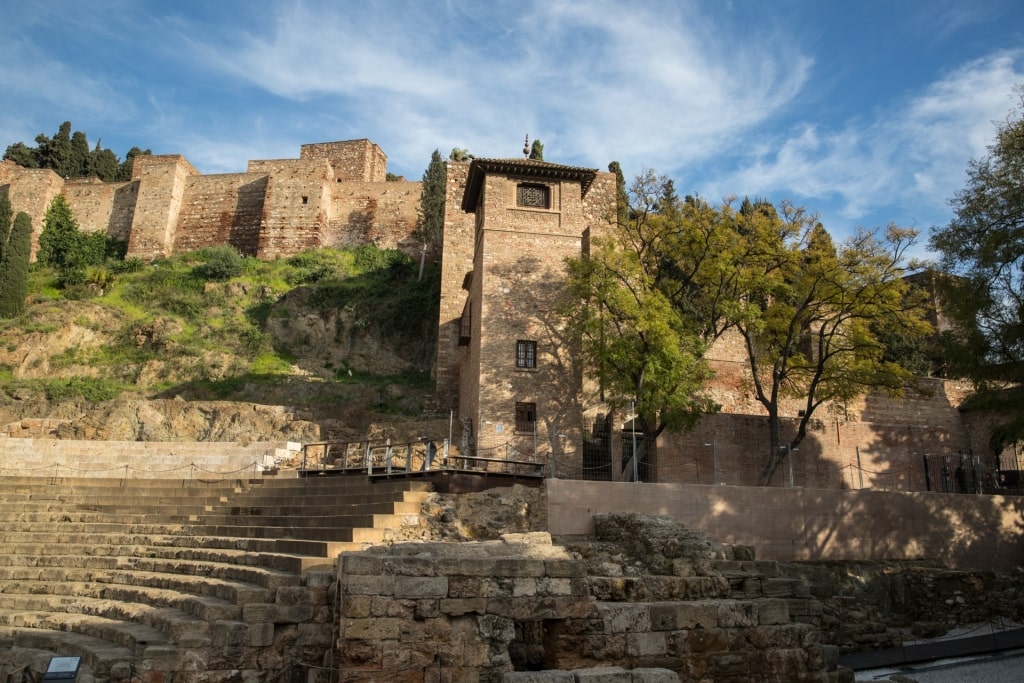
Alcazaba Palace, Malaga
A combination of fortress and palace, the Alcazaba is overlooked by Gibralfaro Castle. Together, they cover the Gibralfaro Hill to make up one of the highlights of any visit to the beautiful Spanish city of Malaga.
The Alcazaba was built around 1060, during the era when Spain was occupied by the Moors, with the Gibralfaro being slightly earlier. Within a series of three forbidding fortified walls are rich palace rooms, lush gardens, and cooling foundations.
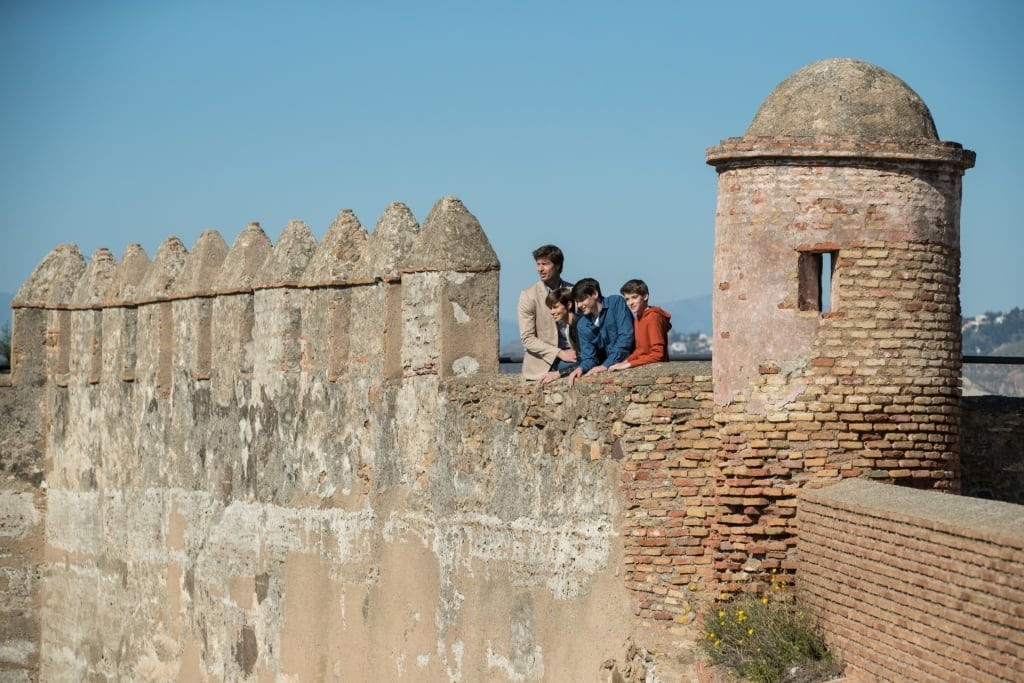
Gibralfaro Castle, Malaga
During the Middle Ages, Gibralfaro Castle was considered almost impregnable. Take the long climb to its highest battlements and you can understand why and enjoy amazing views over the Mediterranean at the same time.
Mercado Central de Atarazanas, Malaga
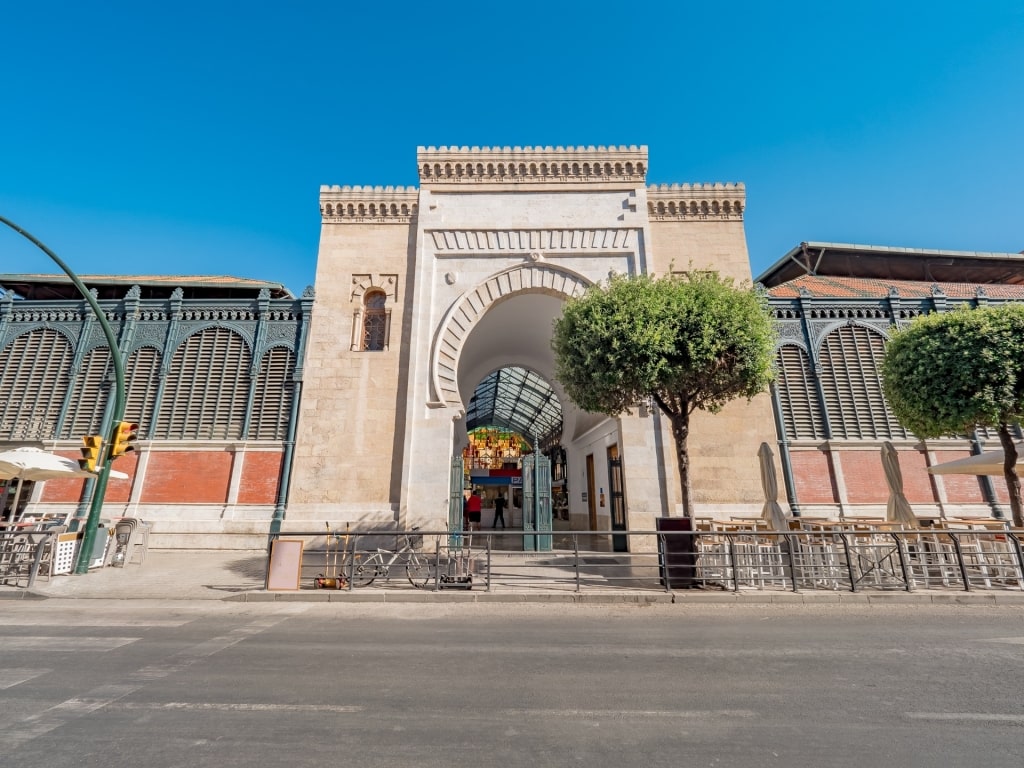
Mercado Central de Atarazanas, Malaga
Malaga’s central market was once the site of a 14th-century Nasrid-era shipyard (atarazanas). The present late-19th-century building, showing off the soaring ironwork style typical of that industrial age, preserves a magnificent Moorish arch from the original.
A painted glass frontage dominates the narrow streets around and casts a splendid light into the interior. Inside, stalls of fresh seafood and colorful fruit or vegetables, make for a photographer’s delight.
This is still a working market where you can buy everything from flowers to Spanish hams. You can also find clothes, crafts, and other souvenirs.
Valldemossa, Mallorca
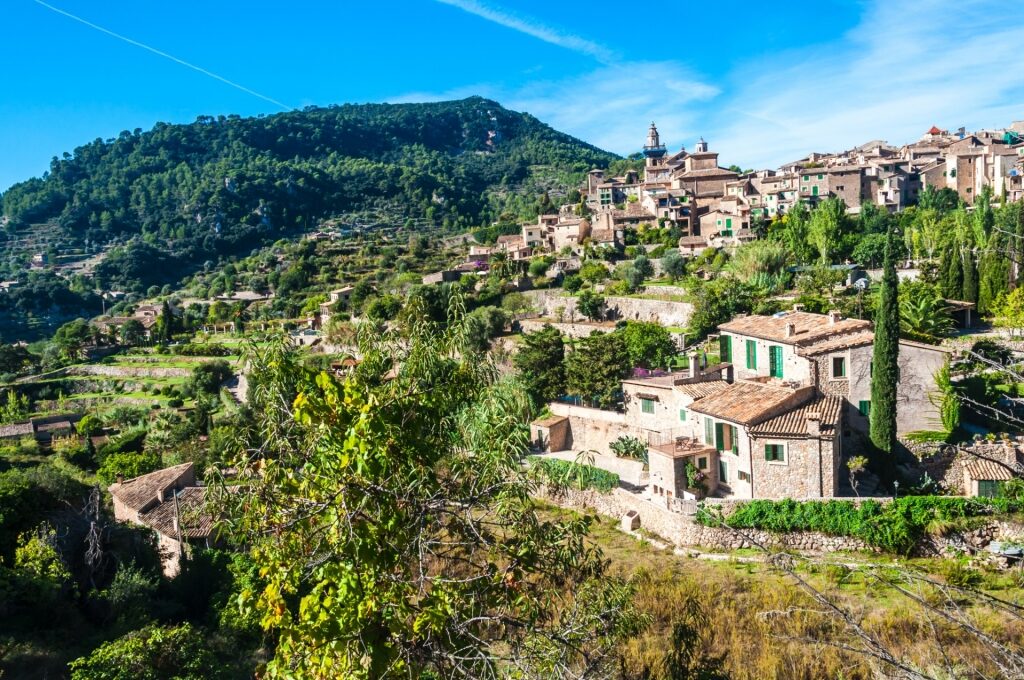
Valldemossa, Mallorca
One of the prettiest places in Spain, Valldemossa sits in Mallorca’s Tramuntana mountain range with a history dating back to Moorish times. However, its most famous building is the Charterhouse, a former 14th-century monastery.
The building now houses a museum dedicated to composer Frédéric Chopin and writer George Sand, who stayed here in the late 1830s. This village in Mallorca retains much of the character it would have had then.
One of the best things to do in Mallorca is to wander around, admiring the charming stone houses with terracotta roofs that line narrow cobblestone streets and picturesque squares. Stop by art galleries and craft shops, or plan a hiking, biking, or climbing adventure in the surrounding mountains.
Plaza de España, Seville

Plaza de España, Seville
This majestic square is a highlight of any visit to Seville. Built for the World Fair of 1929, it’s a colorful, vivacious hybrid of Renaissance and Moorish architectural elements.
The semi-circular plaza faces a central building flanked by two ornate towers and a series of pavilions connected by a canal. Four bridges, representing Castile, Aragon, Navarre, and Leon (Spain’s ancient kingdoms), cross this canal to hold the design together.
As beautiful as the whole are the many detailed elements. These include splendid ceramic tileworks showing scenes from Spanish folklore and history.
Valencia Cathedral, Valencia
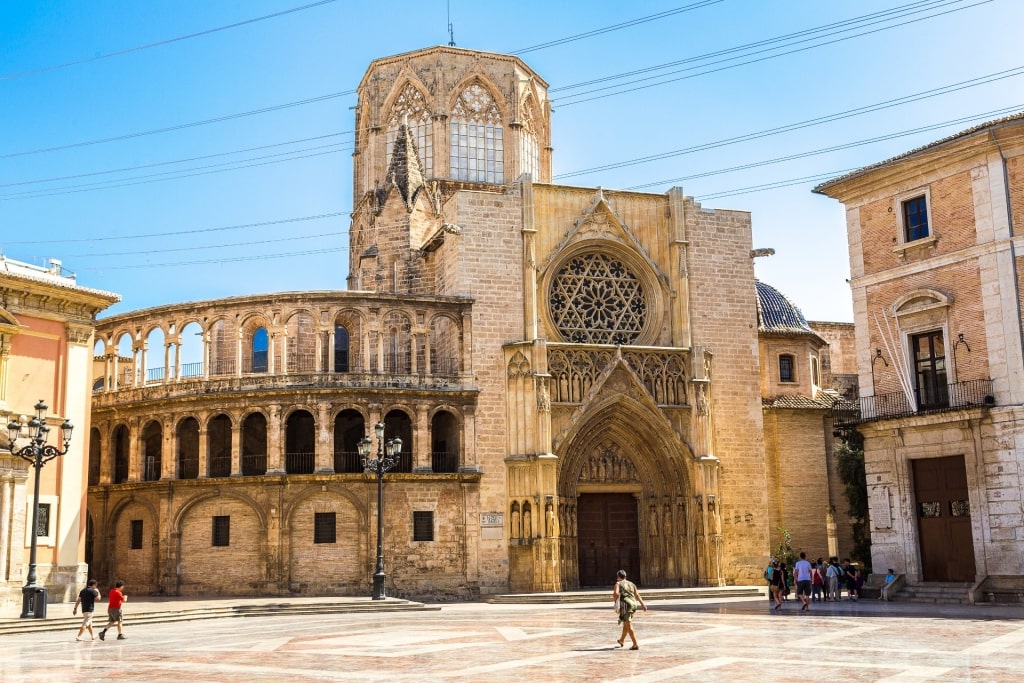
Valencia Cathedral, Valencia
Built over a Roman temple and a later mosque, Valencia Cathedral dates to the 13th century. Much added to since, it has Romanesque as well as Baroque elements but is mostly Gothic in style.
Inside, it is rich with works by artists such as Goya and Vicente López. Paintings, sculptures, and frescoes adorn every corner of the vast space.
However, its greatest treasure is the Holy Chalice, holding the cup said to have been used by Jesus Christ during the Last Supper. This modest cup—the “Holy Grail”—has been dated to the era between the second and first centuries BC and now attracts pilgrims from all over the world.
Cathedral Santiago de Compostela, near Vigo
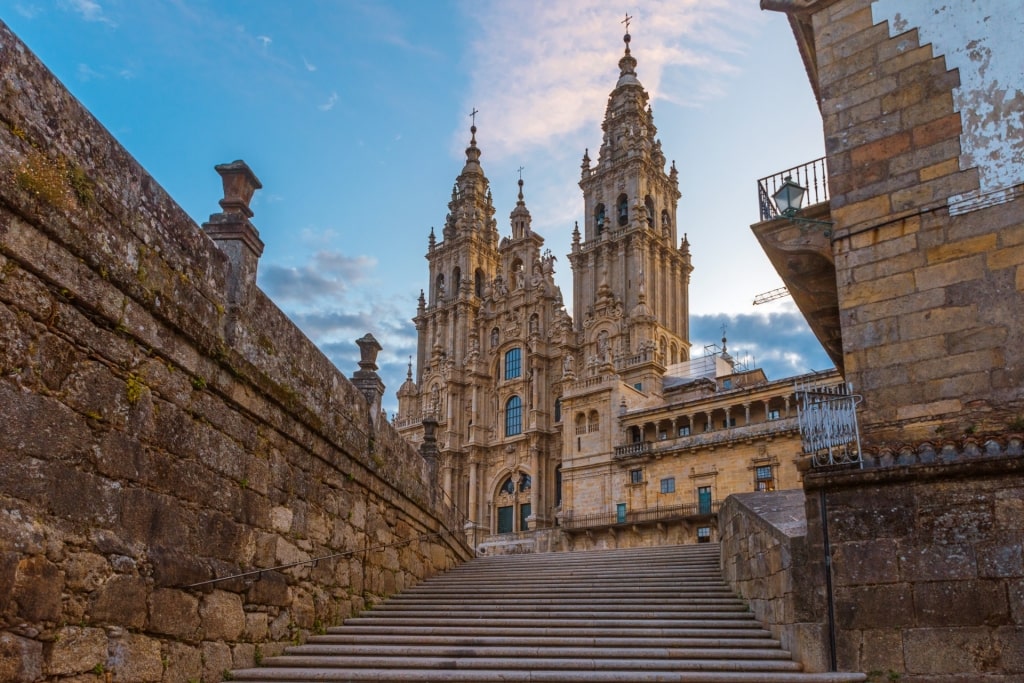
Cathedral Santiago de Compostela, near Vigo
A destination for countless pilgrims, the Cathedral of Santiago de Compostela is a masterpiece of Romanesque, Gothic, and Baroque architecture. It has grown from a small shine built to house the supposed remains of Saint James, one of the Twelve Apostles.
This magnificent cathedral has a facade covered in intricate sculptures, including the notable Portico de la Gloria. This masterpiece of Spanish Romanesque sculpture dates to 1188.
The interior is equally impressive, with a rich collection of religious art, artifacts, and other treasures. The famous Botafumeiro, a large incense burner swung from the ceiling on special occasions, is a highlight for any photographer.
Cies Islands, Vigo
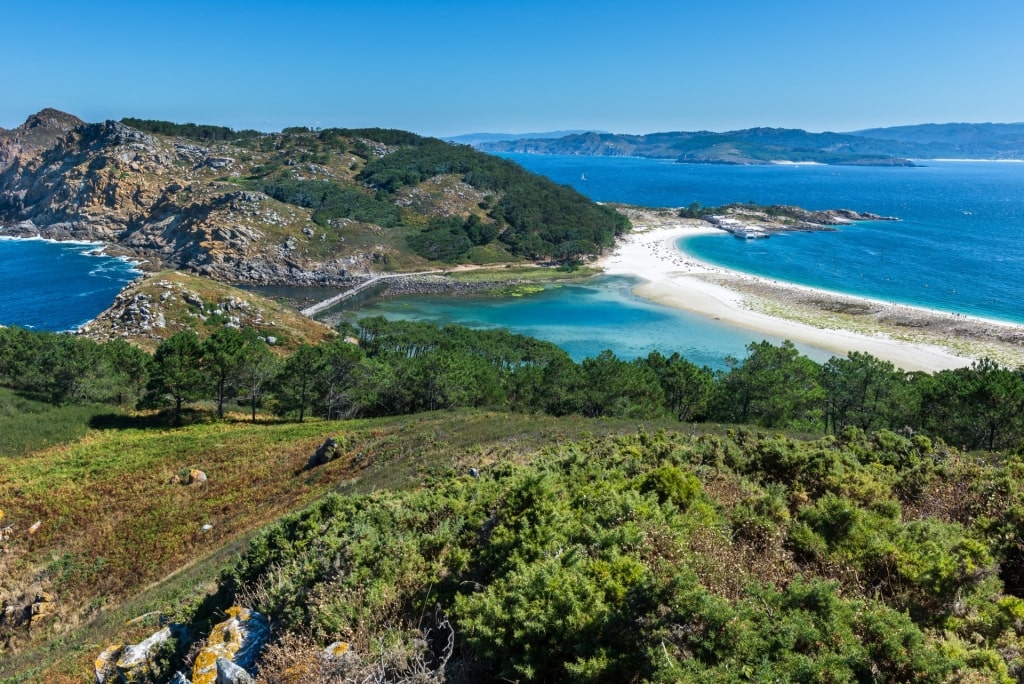
Cies Islands, Vigo
Called the “Islands of the Gods” by the Romans, Galicia’s Cíes Islands earned that name for their beauty. Clear turquoise waters and white sand beaches make the perfect combination for the eye.
Lying in the Vigo estuary, the three islands are a popular escape for beach-lovers and hikers. As part of the Atlantic Islands National Park, they are also a welcome refuge for wildlife, including dolphins.
Two of the islands, Monte Agudo and O Faro, are connected by a beach that is one of the best in Spain. Rodas Beach is more than half a mile long and is delightfully photogenic.
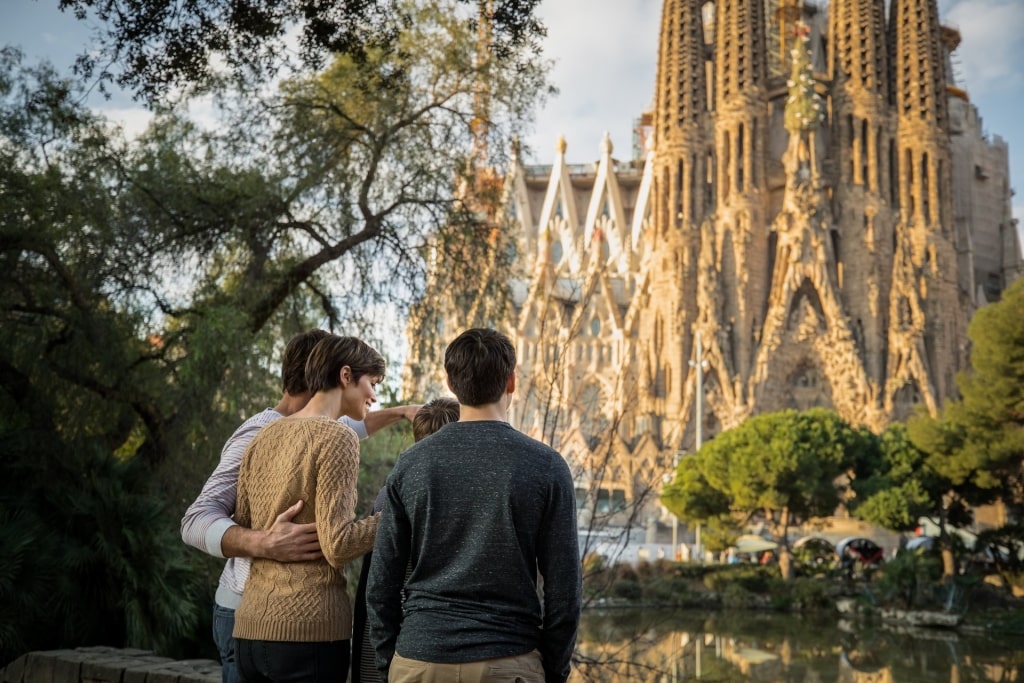
Sagrada Família, Barcelona
If you’re tempted to discover more about the most beautiful places in Spain, discover our luxury cruises to Spain that visit destinations including Barcelona, Malaga, Palma, and Bilbao.
